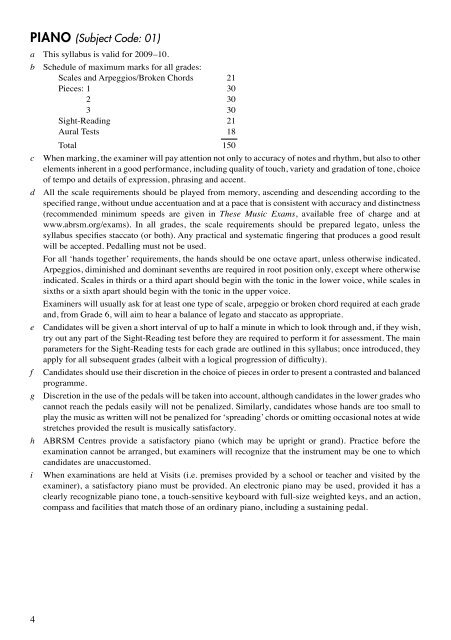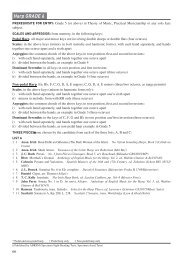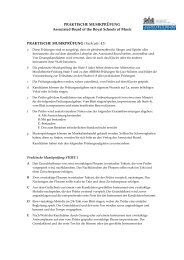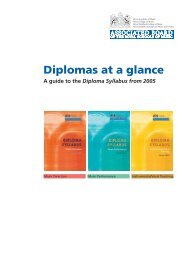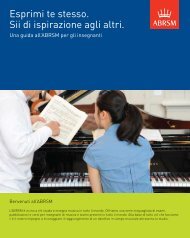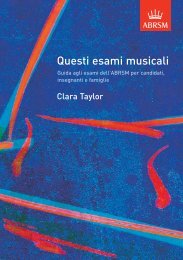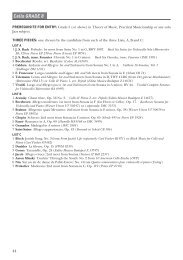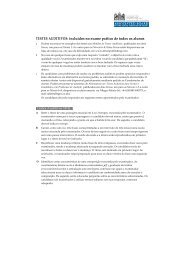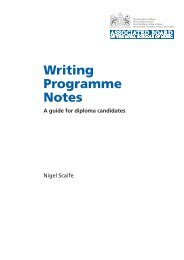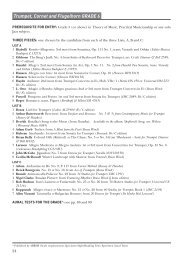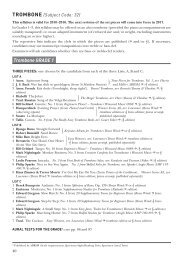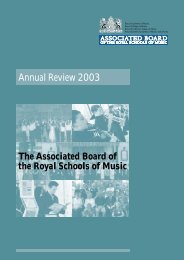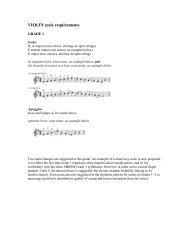PIANO (Subject Code: 01) - ABRSM
PIANO (Subject Code: 01) - ABRSM
PIANO (Subject Code: 01) - ABRSM
- TAGS
- abrsm
- www.abrsm.org
You also want an ePaper? Increase the reach of your titles
YUMPU automatically turns print PDFs into web optimized ePapers that Google loves.
<strong>PIANO</strong> (<strong>Subject</strong> <strong>Code</strong>: <strong>01</strong>)<br />
a This syllabus is valid for 2009–10.<br />
b Schedule of maximum marks for all grades:<br />
Scales and Arpeggios/Broken Chords 21<br />
Pieces: 1 30<br />
Pieces: 2 30<br />
Pieces: 3 30<br />
Sight-Reading 21<br />
Aural Tests 18<br />
Total 150<br />
c When marking, the examiner will pay attention not only to accuracy of notes and rhythm, but also to other<br />
elements inherent in a good performance, including quality of touch, variety and gradation of tone, choice<br />
of tempo and details of expression, phrasing and accent.<br />
d All the scale requirements should be played from memory, ascending and descending according to the<br />
specified range, without undue accentuation and at a pace that is consistent with accuracy and distinctness<br />
(recommended minimum speeds are given in These Music Exams, available free of charge and at<br />
www.abrsm.org/exams). In all grades, the scale requirements should be prepared legato, unless the<br />
syllabus specifies staccato (or both). Any practical and systematic fingering that produces a good result<br />
will be accepted. Pedalling must not be used.<br />
For all ‘hands together’ requirements, the hands should be one octave apart, unless otherwise indicated.<br />
Arpeggios, diminished and dominant sevenths are required in root position only, except where otherwise<br />
indicated. Scales in thirds or a third apart should begin with the tonic in the lower voice, while scales in<br />
sixths or a sixth apart should begin with the tonic in the upper voice.<br />
Examiners will usually ask for at least one type of scale, arpeggio or broken chord required at each grade<br />
and, from Grade 6, will aim to hear a balance of legato and staccato as appropriate.<br />
e Candidates will be given a short interval of up to half a minute in which to look through and, if they wish,<br />
try out any part of the Sight-Reading test before they are required to perform it for assessment. The main<br />
parameters for the Sight-Reading tests for each grade are outlined in this syllabus; once introduced, they<br />
apply for all subsequent grades (albeit with a logical progression of difficulty).<br />
f Candidates should use their discretion in the choice of pieces in order to present a contrasted and balanced<br />
programme.<br />
g Discretion in the use of the pedals will be taken into account, although candidates in the lower grades who<br />
cannot reach the pedals easily will not be penalized. Similarly, candidates whose hands are too small to<br />
play the music as written will not be penalized for ‘spreading’ chords or omitting occasional notes at wide<br />
stretches provided the result is musically satisfactory.<br />
h <strong>ABRSM</strong> Centres provide a satisfactory piano (which may be upright or grand). Practice before the<br />
examination cannot be arranged, but examiners will recognize that the instrument may be one to which<br />
candidates are unaccustomed.<br />
i When examinations are held at Visits (i.e. premises provided by a school or teacher and visited by the<br />
examiner), a satisfactory piano must be provided. An electronic piano may be used, provided it has a<br />
clearly recognizable piano tone, a touch-sensitive keyboard with full-size weighted keys, and an action,<br />
compass and facilities that match those of an ordinary piano, including a sustaining pedal.<br />
4
Piano Regulations & General Requirements<br />
Prep Test. Information about this test, designed as a preparation for the Grade 1 examination and to<br />
encourage the building of good musical and technical foundations, is contained in a separate leaflet. The test,<br />
lasting approximately 10 minutes, takes the form of a positive assessment with no marks or a ‘pass’ or ‘fail’<br />
result. A certificate, incorporating the examiner’s written report, is presented to the candidate at the end of the<br />
assessment. The three tunes, a choice of set pieces and examples of the listening games which comprise the<br />
material used for the assessment are published by <strong>ABRSM</strong> Publishing in Piano Prep Test. Any piece or pieces<br />
from one of the Party Time! for Piano albums or Roundabout (all published by <strong>ABRSM</strong> Publishing) may be<br />
presented as alternatives to the set pieces in Piano Prep Test.<br />
Piano Duet. Examinations for piano duet are available at three levels – Primary, Intermediate and<br />
Advanced. Details of the requirements and suggested pieces are listed under the subject heading Ensembles<br />
in the Harpsichord, Organ, Guitar, Harp, Percussion & Ensembles Syllabus published separately.<br />
EXAMINATION MUSIC AND PERFORMANCE REQUIREMENTS<br />
a The individual sections of the examination may be attempted in any order, at the candidate’s choice.<br />
b Teachers and candidates are advised to pay close attention to the regulations on p. 4 as well as to the<br />
requirements indicated in the current lists of syllabus pieces. A ‘piece’ comprises all the music set under<br />
one number-heading in the syllabus lists (unless an option is specifically indicated). Therefore, a ‘piece’<br />
may comprise more than one movement from a work or more than one item from an album.<br />
c Where appropriate, the initial tempo indication (or section title) of a piece/movement is listed in the<br />
syllabus. Where a piece/movement comprises more than one tempo indication (or section title), the whole<br />
piece/movement is still required to be played in the examination (unless otherwise indicated).<br />
d Candidates failing to observe specific syllabus requirements or regulations (i.e. performing a piece not<br />
listed in the syllabus, or not being prepared to perform the full extent of a piece as indicated in the<br />
syllabus) may be penalized, or, in certain cases, disqualified.<br />
e <strong>ABRSM</strong> offers a limited overlap period, during which pieces from a preceding syllabus may, under<br />
certain conditions, be performed (see Syllabus Updates on the inside front cover of this booklet).<br />
f Candidates may use any edition of the pieces listed in the syllabus, except where a specific arrangement<br />
or transcription is indicated. The editions quoted in the syllabus are given for guidance only and are not<br />
obligatory.<br />
g Candidates may use their discretion regarding indications or markings (particularly editorial) in the music<br />
– e.g. metronome marks, fingering, phrasing, the interpretation of ornaments, etc. – which need not be<br />
strictly observed. Where no such indications are present in the music, candidates should use their<br />
discretion to achieve a musical performance.<br />
h Candidates should observe da capo and dal segno indications, but other repeats of more than a few bars<br />
should not be played in the examination, unless stipulated in the syllabus.<br />
i Performing from memory is optional. The examiner is at liberty to review a copy of the music before or<br />
after the performance of any piece; therefore, candidates performing from memory must ensure that a<br />
copy of the music is available for the examiner’s use.<br />
j Examiners may, at their discretion, stop the performance of any piece when they have heard enough to<br />
form a judgement.<br />
k The Copyright, Design and Patents Act 1988 (UK) does not permit the making or use of photocopies (or<br />
other kinds of copies) of copyright works. However, the UK Music Publishers’Association’s <strong>Code</strong> of Fair<br />
Practice (available at www.mpaonline.org.uk) allows copies to be made in certain limited circumstances<br />
(such as a difficulty with a particular page-turn) but only if the copyright holder is listed in Appendix C<br />
of the <strong>Code</strong>. In all other cases, application should be made to the copyright holder before any copy is<br />
made. It is the Applicant’s responsibility to ensure that candidates act within the law with respect to the<br />
making and use of photocopies (or other copies). <strong>ABRSM</strong> reserves the right to withhold the examination<br />
result of any candidate where it has evidence of the use of an illegal copy (or copies) in connection with<br />
that examination.<br />
5
Piano GRADE 1<br />
SCALES AND BROKEN CHORDS*: see also para d on p. 4<br />
Scales<br />
C, G, D, F majors hands separately 2 octaves<br />
A, D minors (L.H. may, at the candidate’s choice, be<br />
(melodic or harmonic at candidate’s<br />
choice)<br />
Contrary-motion scale<br />
played descending and ascending)<br />
C major<br />
Broken chords<br />
hands beginning on the key-note (unison) 1 octave<br />
C, G, F majors hands separately, according to the pattern<br />
A, D minors below:<br />
THREE PIECES: one chosen by the candidate from each of the three Lists, A, B and C:<br />
LIST A<br />
1 Duncombe Gavot: from First Book of Progressive Lessons<br />
Selected Piano Exam Pieces 2009–2<strong>01</strong>0, Grade 1<br />
2 Kirnberger Minuetto<br />
(<strong>ABRSM</strong> Publishing)<br />
3 Vivaldi Autumn (from The Four Seasons), arr. Wedgwood<br />
4 Gläser Angloise. No. 11 from Clavierstücke für Anfänger (Schott ED 2572/MDS)<br />
5 Handel March in G, HWV 4193 ⎫<br />
⎬<br />
†<br />
⎭<br />
. No. 7 from Handel Easy Piano Pieces and Dances (Bärenreiter BA 6578)<br />
6 Purcell Minuet in A minor, Z. 649. No. 1 from A Keyboard Anthology, Third Series, Book 1 or No. 15 from<br />
Baroque Keyboard Pieces, Book 1 or No. 10 from English Keyboard Music 1663–1702 (<strong>ABRSM</strong> Publishing)<br />
LIST B<br />
1 Dunhill A Song of Erin: No. 8 from First Year Pieces<br />
⎫<br />
Selected Piano Exam Pieces 2009–2<strong>01</strong>0,<br />
2 Gedike Kummer (Grief): No. 39 from 60 leichte Klavierstücke, Op. 36 ⎬<br />
Grade 1 (<strong>ABRSM</strong> Publishing)<br />
† 3 Trad. English Early one morning, arr. Barratt<br />
⎭<br />
† 4 Dvoˇrák Cavatina: No. 1 from Miniatures (Op. 75a). Simply Classics, Grades 0–1, arr. Gritton (Faber)<br />
5 Marjorie Helyer Dragonflies: from The Greenwood Tree (Stainer & Bell)<br />
† 6 Schubert Theme from the ‘Unfinished’ Symphony. Piano Time Classics, arr. Hall (OUP)<br />
LIST C<br />
1 Árpád Balázs Trudging<br />
⎫<br />
Selected Piano Exam Pieces 2009–2<strong>01</strong>0, Grade 1<br />
2 Paul Drayton Never Vex a Tyrannosaurus Rex! ⎬<br />
(<strong>ABRSM</strong> Publishing)<br />
3 John Rowcroft African Dance<br />
⎭<br />
4 Chen Yi Singing in the Mountain. Spectrum 4: An International Collection of 66 Miniatures for Solo Piano<br />
(<strong>ABRSM</strong> Publishing)<br />
5 Alan Haughton Bluemerang. Piano Time Going Places, arr. Hall (OUP)<br />
6 Kabalevsky My Stubborn Little Brother: from 35 Pieces for Piano, Op. 89. Gradations (Boosey & Hawkes/MDS)<br />
or Keynotes, Grades 1–2 (Faber)<br />
SIGHT-READING*: a four- or six-bar piece in 4 4 , 3 4 or 2 4 in C, G or F majors, A or D minors, with each hand<br />
playing separately and in a five-finger position. Simple dynamics, note values, articulations and occasional<br />
accidentals (within minor keys only) may be encountered. See also para e on p. 4.<br />
AURAL TESTS FOR THE GRADE*: see p. 16<br />
† This arrangement only<br />
* Published by <strong>ABRSM</strong> Publishing (Scale requirements, Specimen Sight-Reading Tests, Specimen Aural Tests)<br />
6<br />
V 68 Š Š Š Š Š Š Š Š Š Š. Š Š Š Š Š Š Š Š Š Š.
Piano GRADE 2<br />
SCALES, ARPEGGIOS AND BROKEN CHORDS*: see also para d on p. 4<br />
Scales (similar motion)<br />
G, D, A, F majors<br />
E, D, G minors<br />
(melodic or harmonic at candidate’s<br />
choice)<br />
Contrary-motion scales<br />
hands together and separately 2 octaves<br />
C, E majors<br />
Chromatic scale<br />
hands beginning on the key-note (unison) 2 octaves<br />
beginning on D<br />
Arpeggios<br />
hands separately 1 octave<br />
G, D, A majors<br />
D, G minors<br />
Broken chords<br />
hands separately 2 octaves<br />
F major hands separately, according to the pattern<br />
E minor below:<br />
Vb Š Š Š Š Š Š Š Š Š Š Š Š Š Š Š Š Š Š Š Š Š Š Š Š Š Š Š Š Š Š Š Š<br />
THREE PIECES: one chosen by the candidate from each of the three Lists, A, B and C:<br />
LIST A<br />
1 Bertini Rondo<br />
2 Biehl Allegro grazioso: 2nd movt from Sonatina in C, Op. 57 No. 1<br />
3 Haydn Gypsy Dance: No. 6 from Zingarese, Hob. IX/28<br />
⎫<br />
⎬<br />
⎭<br />
Selected Piano Exam Pieces 2009–2<strong>01</strong>0,<br />
Grade 2 (<strong>ABRSM</strong> Publishing)<br />
4 Beethoven Allemande: No. 2 from 12 Allemandes, WoO 8. Keynotes, Grades 1–2 (Faber)<br />
5 J. A. Hiller Minuetto 1. No. 2a from Kleine leichte Clavierstücke (Simple Short Piano Pieces) (Schott ED 2425/MDS)<br />
6 Mozart Contredance in G, K. 15e. No. 16 from Mozart 25 Early Pieces (<strong>ABRSM</strong> Publishing)<br />
LIST B<br />
† 1 Delibes Mazurka: from Coppélia, arr. Scott ⎫ Selected Piano Exam Pieces<br />
2 Reinecke Allegro moderato: 1st movt from Sonatina in G, Op. 136 No. 2 ⎬<br />
3 Reizenstein The First Snowdrop ⎭<br />
2009–2<strong>01</strong>0, Grade 2<br />
(<strong>ABRSM</strong> Publishing)<br />
† 4 Bizet March: from L’arlésienne. Music Through Time, Piano Book 2, arr. Hall and Harris (OUP)<br />
5 Schumann Trällerliedchen (Humming Song): No. 3 from Album für die Jugend, Op. 68 (<strong>ABRSM</strong> Publishing) also<br />
in Schumann For Younger People and No. 16 from A Keyboard Anthology, Third Series, Book 1 (<strong>ABRSM</strong> Publishing)<br />
6 Robert Washburn Valse triste. Piano Time Pieces, Book 2, arr. Hall (OUP)<br />
LIST C<br />
† 1 Eric Clapton Wonderful Tonight, arr. McNamara<br />
2 Elissa Milne Mozzie: from Easy Little Peppers<br />
3 Giles Swayne Whistling Tune<br />
⎫<br />
⎬<br />
⎭<br />
Selected Piano Exam Pieces 2009–2<strong>01</strong>0, Grade 2<br />
(<strong>ABRSM</strong> Publishing)<br />
†<br />
4 L. Bart Reviewing the Situation (from Oliver!). More Making the Grade, Grade 2, arr. Frith (Chester/Music Sales)<br />
5 M. Hurd Fanfare: from Bagatelles. A Century of Piano Music, Grades 1–4 (Bosworth/Music Sales)<br />
6 Manfred Schmitz Tango für Elise: No. 16 from Mini Tango (DVfM 32148/Breitkopf & Härtel)<br />
SIGHT-READING*: a four- or six-bar piece, time and key signatures as Grade 1, with the addition of D major,<br />
E and G minors, and with each hand in a five-finger position and playing together. Some dotted and tied notes<br />
may be encountered. See also para e on p. 4.<br />
AURAL TESTS FOR THE GRADE*: see p. 16<br />
7
Piano GRADE 3<br />
SCALES AND ARPEGGIOS*: see also para d on p. 4<br />
Scales (similar motion)<br />
A, E, B, Bb, Eb majors<br />
B, G, C minors<br />
(melodic or harmonic at candidate’s<br />
choice)<br />
Contrary-motion scales<br />
hands together and separately 2 octaves<br />
A major hands beginning on the key-note 2 octaves<br />
A harmonic minor (unison)<br />
Chromatic scales<br />
beginning on Ab and on C<br />
Arpeggios<br />
hands separately 2 octaves<br />
A major<br />
G minor<br />
hands together only 2 octaves<br />
E, B, Bb, Eb majors<br />
B, C minors<br />
hands separately only 2 octaves<br />
THREE PIECES: one chosen by the candidate from each of the three Lists, A, B and C:<br />
LIST A<br />
1 Anon. Menuet in G, BWV Anh. II 116: from Clavierbüchlein vor Anna ⎫<br />
Selected Piano Exam Pieces<br />
Magdalena Bach, 1725<br />
⎩<br />
2009–2<strong>01</strong>0, Grade 3<br />
† 2 T. Morley Now is the month of maying, arr. Gritton<br />
⎧<br />
(<strong>ABRSM</strong> Publishing)<br />
3 attrib. Mozart Andante in C: No. 1 from 12 petites pièces<br />
⎭<br />
4 Attwood Allegro assai: 3rd movt from Sonatina No. 3 in F. Attwood Easy Progressive Lessons (<strong>ABRSM</strong> Publishing)<br />
5 Clementi Vivace: 3rd movt from Sonatina in C, Op. 36 No. 1. No. 1 from Clementi Sonatinas, Op. 36 & 4<br />
(<strong>ABRSM</strong> Publishing)<br />
6 Weber Scherzo. The Joy of First Classics, Book 2 (Yorktown Music Press/Music Sales)<br />
LIST B<br />
1 Absil Petit berger: No. 8 from Du rythme à l’expression, Book 2, Op. 108 ⎫ Selected Piano Exam Pieces<br />
2 Loeschhorn Study in F, Op. 65 No. 25 ⎬ 2009–2<strong>01</strong>0, Grade 3<br />
† 3 Saint-Saëns The Elephant: from The Carnival of the Animals, arr. Heumann ⎭ (<strong>ABRSM</strong> Publishing)<br />
4 Gounod Les pifferari (The Bagpipers). Gounod Funeral March of a Marionette and Other Pieces or No. 16 from<br />
A Keyboard Anthology, Second Series, Book 2 (<strong>ABRSM</strong> Publishing)<br />
5 Reinecke Andantino: 2nd movt from Sonatina in C, Op. 136 No. 1. Reinecke Six Miniature Sonatinas, Op. 136<br />
(Breitkopf & Härtel EB 8110)<br />
6 Sandré Go to Sleep: from For the Little Ones. A Romantic Sketchbook for Piano, Book 1 (<strong>ABRSM</strong> Publishing)<br />
LIST C<br />
1 Chow Shu San Tell You: from Chinese Short Pieces<br />
Selected Piano Exam Pieces 2009–2<strong>01</strong>0, Grade 3<br />
2 Hanna, Barbera and Curtin Top Cat!, arr. Burt<br />
(<strong>ABRSM</strong> Publishing)<br />
3 T. Hold Quajira (observing repeat)<br />
4 Mike Cornick Waltz in F (observing repeat): from On the Right Track, Level 1 (Universal 21124/MDS)<br />
5 Richard Kershaw Jack’s Asleep!: No. 2 from World Jazz Tour (Spartan Press SP545)<br />
6 Pe – ⎫<br />
†<br />
⎬<br />
⎭<br />
teris Plakidis Quiet Walk in the Forest. Spectrum 4: An International Collection of 66 Miniatures for Solo<br />
Piano (<strong>ABRSM</strong> Publishing)<br />
SIGHT-READING*: a piece of up to eight bars in length, with the addition of 3 8 and A, Bb, Eb majors and B<br />
minor, and with hands playing together outside of a five-finger position. Occasional two-note chords in either<br />
hand may be encountered. See also para e on p. 4.<br />
AURAL TESTS FOR THE GRADE*: see pp. 16 and 17<br />
8
Piano GRADE 4<br />
SCALES AND ARPEGGIOS*: see also para d on p. 4<br />
Scales (similar motion)<br />
B, Bb, Eb, Ab, Db majors<br />
C<br />
hands together and separately 2 octaves<br />
# , G # , C, F minors<br />
(melodic or harmonic at candidate’s<br />
choice)<br />
Contrary-motion scales<br />
F, Eb majors hands beginning on the key-note 2 octaves<br />
D, C harmonic minors<br />
Chromatic scales<br />
(unison)<br />
beginning on any black key named by<br />
the examiner<br />
hands together and separately 2 octaves<br />
Arpeggios<br />
B, Bb, Eb, Ab, Db majors<br />
C<br />
hands together and separately 2 octaves<br />
# , G # , C, F minors<br />
THREE PIECES: one chosen by the candidate from each of the three Lists, A, B and C:<br />
LIST A<br />
1 G. Benda Allegro assai: 3rd movt from Sonata in G ⎫ Selected Piano Exam Pieces<br />
2 Handel Allegro in F, HWV 488 ⎬ 2009–2<strong>01</strong>0, Grade 4<br />
3 J. S. Bach Bourrée 1: from Ouvertüre nach Französischer Art, BWV 831 ⎭ (<strong>ABRSM</strong> Publishing)<br />
4 J. C. F. Bach Angloise in D. No. 16 from J. C. F. Bach Musical Leisure Hours (<strong>ABRSM</strong> Publishing)<br />
†<br />
5 Beethoven Symphony No. 1: 4th movt. Simply Classics, Grades 4–5, arr. Gritton (Faber)<br />
6 Mozart Rondo in D, K. 15d. No. 22 from Mozart 25 Early Pieces (<strong>ABRSM</strong> Publishing)<br />
LIST B<br />
1 Volkmann Lied der Grossmutter: No. 10 from Lieder der Grossmutter, Op. 27 ⎫ Selected Piano Exam Pieces<br />
2 Schubert Two Waltzes: Nos 3 and 4 from Original Tänze, Op. 9 (D. 365)<br />
3 Vaughan Williams Valse lente: from Six Teaching Pieces<br />
4 Carroll The Reef: No. 5 from In Southern Seas (Forsyth)<br />
5 S. Heller Study in A minor: No. 17 from 25 Etüden, Op. 47 (Peters EP 3563)<br />
⎬<br />
⎭<br />
2009–2<strong>01</strong>0, Grade 4<br />
(<strong>ABRSM</strong> Publishing)<br />
6 Schumann Erster Verlust (First Loss): No. 16 from Album für die Jugend, Op. 68 (<strong>ABRSM</strong> Publishing) also in<br />
Schumann For Younger People and No. 13 from A Keyboard Anthology, First Series, Book 2 (<strong>ABRSM</strong> Publishing)<br />
LIST C<br />
1 Hoddinott Leapfrog<br />
2 Kabalevsky Sonatina: No. 18 from 30 Children’s Pieces, Op. 27<br />
3 Gerald Schwertberger Honky Tonk Piano Rag: from Happy Piano<br />
⎫<br />
⎬<br />
⎭<br />
Selected Piano Exam Pieces 2009–2<strong>01</strong>0,<br />
Grade 4 (<strong>ABRSM</strong> Publishing)<br />
4 Bartók Tanz aus Butschúm: No. 4 from Rumänische Volkstänze (Universal 5802/MDS)<br />
5 Heather Hammond On the Swing: from Cool Piano 3 (Kevin Mayhew)<br />
6 Alan Haughton Stephanie’s Song: No. 10 from Rhythm and Rag (<strong>ABRSM</strong> Publishing)<br />
SIGHT-READING*: a piece of around eight bars in length, with the addition of 6 8 , keys as Grade 3. Anacrusis<br />
and occasional chromatic notes, pause signs and tenuto may be encountered. See also para e on p. 4.<br />
AURAL TESTS FOR THE GRADE*: see pp. 16 and 17<br />
† This arrangement only<br />
* Published by <strong>ABRSM</strong> Publishing (Scale requirements, Specimen Sight-Reading Tests, Specimen Aural Tests)<br />
9
Piano GRADE 5<br />
SCALES AND ARPEGGIOS*: see also para d on p. 4<br />
Scales (similar motion)<br />
all keys, major and minor<br />
(minors melodic or harmonic at candidate’s<br />
choice)<br />
hands together and separately 3 octaves<br />
Contrary-motion scales<br />
Group 1: F, Db/C # majors and harmonic minors<br />
or Group 2: F<br />
hands beginning on the key-note 2 octaves<br />
# , Bb majors and harmonic minors<br />
Chromatic scales<br />
(unison)‡<br />
beginning on any note named by the examiner hands together and separately 3 octaves<br />
Chromatic contrary-motion scales<br />
beginning on D (unison) and on Ab (unison)<br />
Arpeggios<br />
2 octaves<br />
all keys, major and minor hands together and separately 3 octaves<br />
THREE PIECES: one chosen by the candidate from each of the three Lists, A, B and C:<br />
LIST A<br />
1 Haydn Vivace assai: No. 11 from 12 petites pièces ⎫ Selected Piano Exam Pieces<br />
2 Kuhlau Allegro con affetto: 1st movt from Sonatina in A minor, Op. 88 No. 3 ⎬ 2009–2<strong>01</strong>0, Grade 5<br />
3 Richard Jones Giga: 5th movt from Suite No. 4 in A minor ⎭ (<strong>ABRSM</strong> Publishing)<br />
4 Handel Ouverture: 1st movt from Suite in D minor, HWV 448. No. 13 from Handel Easy Piano Pieces and Dances<br />
(Bärenreiter BA 6578)<br />
5 J. N. Hummel Allegro in C: No. 2 from Six pièces très faciles, Op. 52. No. 9 from Hummel 16 Short Pieces<br />
(<strong>ABRSM</strong> Publishing)<br />
6 Ludvig Schytte Allegro molto: 3rd movt from Sonatina, Op. 76 No. 3. No. 24 from The New Sonatina Book, Vol. 1<br />
(Schott ED 2511/MDS)<br />
LIST B<br />
1 J. S. Bach Andante: 3rd movt from Sonata in D minor, BWV 964 Selected Piano Exam Pieces<br />
2 Grieg Norwegian Air: No. 6 from Lyric Pieces, Book 1, Op. 12<br />
3 Schumann Von fremden Ländern und Menschen: No. 1 from Kinderscenen, Op. 15<br />
2009–2<strong>01</strong>0, Grade 5<br />
(<strong>ABRSM</strong> Publishing)<br />
4 J. F. F. Burgmüller L’hirondelle (The Swallow): No. 24 from 25 Easy and Progressive Studies, Op. 100 (<strong>ABRSM</strong><br />
Publishing) also in More Romantic Pieces for Piano, Book 3 (<strong>ABRSM</strong> Publishing)<br />
5 C. Franck Lento in C # ⎫<br />
⎬<br />
⎭<br />
minor: from L’organiste. No. 15 from Franck 18 Short Selected Pieces (Peters EP 4529)<br />
6 H. Hofmann Ländler (Country Waltz): No. 3 from Skizzen, Op. 77 (observing first repeat). No. 3 from H. Hofmann<br />
17 Miscellaneous Pieces (<strong>ABRSM</strong> Publishing)<br />
LIST C<br />
1 Mike Cornick In the Groove: from 20 Piano Studies ⎫ Selected Piano Exam Pieces<br />
2 Tan Dun Staccato Beans: No. 2 from Eight Memories in Watercolor ⎬<br />
3 Koechlin En faisant un bouquet: No. 7 from Dix petites pièces faciles, Op. 41b ⎭<br />
2009–2<strong>01</strong>0, Grade 5<br />
(<strong>ABRSM</strong> Publishing)<br />
4 Saúl Cosentino A la memoria de Astor. Tango nuevo for piano solo, Vol. 1 or separately (Tonos)<br />
5 Prokofiev La pluie et l’arc-en-ciel (The Rain and the Rainbow): No. 8 from Musiques d’enfants, Op. 65 (Boosey &<br />
Hawkes/MDS)<br />
6 Satie Méditation: No. 3 from Avant-dernières pensées. Satie Piano Works, Vol. 3 (Schott ED 9028/MDS)<br />
SIGHT-READING*: a piece of around eight to twelve bars in length, time signatures as Grade 4, keys up to<br />
four sharps/flats (major) or three sharps/flats (minor). Four-part chords (two notes maximum in either hand),<br />
simple syncopation and a slowing of tempo at the end may be encountered. See also para e on p. 4.<br />
AURAL TESTS FOR THE GRADE*: see pp. 16 and 18<br />
‡ The candidate chooses one of the two groups § Same group as chosen above<br />
* Published by <strong>ABRSM</strong> Publishing (Scale requirements, Specimen Sight-Reading Tests, Specimen Aural Tests)<br />
10
Piano GRADE 6<br />
PREREQUISITE FOR ENTRY: Grade 5 (or above) in Theory of Music, Practical Musicianship or any solo Jazz<br />
subject.<br />
SCALES AND ARPEGGIOS*: see also para d on p. 4<br />
Scales (similar motion)<br />
all keys, major and minor<br />
(minors both melodic and harmonic)<br />
legato, hands together and separately 4 octaves<br />
Staccato scales<br />
Group 1: A, Eb majors<br />
or Group 2: E, Bb majors<br />
hands separately‡ 4 octaves<br />
Contrary-motion scales<br />
Group 1: A, Eb majors and harmonic minors<br />
or Group 2: E, Bb majors and harmonic minors<br />
Staccato scale in thirds<br />
legato, hands beginning on the key-note<br />
(unison)‡§<br />
2 octaves<br />
C major<br />
Chromatic scales<br />
hands separately 2 octaves<br />
beginning on any note named by the examiner<br />
Chromatic contrary-motion scale<br />
legato, hands together and separately 4 octaves<br />
beginning on A # (L.H.) and C # (R.H.), a minor<br />
third apart<br />
Arpeggios<br />
legato 2 octaves<br />
all keys, major and minor<br />
Diminished sevenths<br />
legato, hands together and separately 4 octaves<br />
beginning on B and on C # legato, hands together and separately 4 octaves<br />
THREE PIECES: one chosen by the candidate from each of the three Lists, A, B and C:<br />
LIST A<br />
1 F. Couperin Les petits moulins à vent<br />
⎫<br />
Selected Piano Exam Pieces 2009–2<strong>01</strong>0, Grade 6<br />
2 Mozart Courante: 3rd movt from Suite in C, K. 399/385i ⎬<br />
(<strong>ABRSM</strong> Publishing)<br />
3 D. Scarlatti Sonata in D minor, Kp. 9 (L. 413) ⎭<br />
4 C. P. E. Bach Solfeggietto in C minor, Wq. 117/2. No. 1 from C. P. E. Bach Selected Keyboard Works, Book 2<br />
(<strong>ABRSM</strong> Publishing)<br />
5 Clementi Rondo (Allegro spiritoso): 2nd movt from Sonatina in D, Op. 36 No. 6. No. 6 from Clementi Sonatinas,<br />
Op. 36 & 4 (<strong>ABRSM</strong> Publishing)<br />
6 Telemann Vivace: 1st movt from Fantasia No. 5 in F (First Dozen), TWV 33:5. Telemann Fantasias, First Dozen<br />
(<strong>ABRSM</strong> Publishing)<br />
LIST B<br />
1 Beethoven Adagio: 2nd movt from Sonata in C, WoO 51 ⎫ Selected Piano Exam Pieces<br />
2 Chopin Moderato ⎬ 2009–2<strong>01</strong>0, Grade 6<br />
3 Stenhammar Molto tranquillo, semplice: No. 1 from Three Little Piano Pieces ⎭<br />
(<strong>ABRSM</strong> Publishing)<br />
4 Glière Prelude in Db: No. 1 from Eight Easy Pieces, Op. 43 (<strong>ABRSM</strong> Publishing) also in A Romantic Sketchbook for<br />
Piano, Book 4 (<strong>ABRSM</strong> Publishing)<br />
5 Liszt Klavierstück in Ab (S. 189a). No. 6 from Liszt Easy Piano Pieces and Dances (Bärenreiter BA 6577)<br />
6 Schubert Allegretto in C minor, D. 915. No. 9 from Schubert Nine Short Piano Pieces or No. 8 from A Keyboard<br />
Anthology, Second Series, Book 4 (<strong>ABRSM</strong> Publishing)<br />
LIST C<br />
1 M. Arnold The Buccaneer: from Eight Children’s Pieces, Op. 36 ⎫ Selected Piano Exam Pieces<br />
2 Oscar Peterson Jazz Exercise No. 2: from Jazz Piano for the Young Pianist, Vol. 3 ⎬<br />
3 Satie Gnossienne No. 3 ⎭<br />
4 Poulenc Staccato: No. 2 from Villageoises (Salabert/UMP)<br />
2009–2<strong>01</strong>0, Grade 6<br />
(<strong>ABRSM</strong> Publishing)<br />
5 Mark-Anthony Turnage Tune for Toru: No. 5 from True Life Stories (Schott ED 12677/MDS)<br />
6 Villa-Lobos Rosa Amarela: No. 2 from Guia prático (Practical Guide), Album 4 (not observing dal segno)<br />
(Eschig/UMP)<br />
11
Piano: GRADE 6<br />
SIGHT-READING*: a piece of around twelve to sixteen bars in length, with the addition of 9 8 , 5 4 and 5 8 , keys<br />
up to four sharps/flats (major and minor). Triplet rhythms, some clef changes and sparing use of the right<br />
pedal may be encountered. See also para e on p. 4.<br />
AURAL TESTS FOR THE GRADE*: see pp. 16 and 18<br />
Piano GRADE 5<br />
Piano GRADE 7<br />
PREREQUISITE FOR ENTRY: Grade 5 (or above) in Theory of Music, Practical Musicianship or any solo Jazz<br />
subject.<br />
SCALES AND ARPEGGIOS*: see also para d on p. 4<br />
Scales (similar motion)<br />
Group 1: C, D, E, F # , Bb, Ab/G # majors & minors<br />
or Group 2: G, A, B, F, Eb, Db/C<br />
legato or staccato as directed by 4 octaves<br />
# majors & minors the examiner, hands together<br />
(minors both melodic and harmonic)<br />
Scales a third apart<br />
and separately‡<br />
Group 1 keys as above<br />
or Group 2 (minors: harmonic form only)<br />
Contrary-motion scales<br />
legato or staccato as directed by<br />
the examiner, hands together‡§<br />
4 octaves<br />
Group 1 keys as above<br />
or Group 2 (minors: harmonic form only)<br />
Legato scale in thirds<br />
legato or staccato as directed by<br />
the examiner, hands beginning on<br />
the key-note (unison)‡§<br />
2 octaves<br />
C major<br />
Staccato scale in sixths<br />
hands separately 2 octaves<br />
C major<br />
Chromatic scales<br />
hands separately 2 octaves<br />
beginning on any note named by the examiner<br />
Chromatic contrary-motion scales<br />
legato or staccato as directed by<br />
the examiner, hands together and<br />
separately<br />
4 octaves<br />
beginning on C (unison) and on F # (unison)<br />
Arpeggios<br />
legato or staccato as directed by<br />
the examiner<br />
2 octaves<br />
Group 1<br />
keys as above<br />
or Group 2<br />
legato, hands together and separately,<br />
in root position and first<br />
inversion‡§<br />
4 octaves<br />
Dominant sevenths<br />
Group 1: in the keys of C, D, E, F # , Bb, Ab<br />
or Group 2: in the keys of G, A, B, F, Eb, Db<br />
Diminished sevenths<br />
legato, hands together and separately‡§<br />
4 octaves<br />
beginning on A and on C # ⎫<br />
⎬<br />
⎭<br />
⎫<br />
⎬<br />
⎭<br />
⎫<br />
⎬<br />
⎭<br />
legato, hands together and separately<br />
4 octaves<br />
‡ The candidate chooses one of the two groups § Same group as chosen above<br />
* Published by <strong>ABRSM</strong> Publishing (Scale requirements, Specimen Sight-Reading Tests, Specimen Aural Tests)<br />
12
Piano: GRADE 7<br />
THREE PIECES: one chosen by the candidate from each of the three Lists, A, B and C:<br />
LIST A<br />
1 J. C. F. Bach Allegro assai: 3rd movt from Sonata No. 6 in Eb, WXI/3 ⎫<br />
Selected Piano Exam Pieces 2009–2<strong>01</strong>0,<br />
2 Haydn Allegro di molto: 2nd movt from Sonata in Bb, Hob. XVI/41 ⎬<br />
Grade 7 (<strong>ABRSM</strong> Publishing)<br />
3 D. Scarlatti Sonata in F minor, Kp. 69 (L. 382)<br />
⎭<br />
4 J. S. Bach Prelude in G, BWV 860/1: No. 15 from The Well-Tempered Clavier, Part 1 (<strong>ABRSM</strong> Publishing)<br />
5 Handel Allegro in D minor, HWV 475. No. 11 from Handel Selected Keyboard Works, Book 2 (<strong>ABRSM</strong><br />
Publishing)<br />
6 Haydn Finale (Presto): 2nd movt from Sonata in D, Hob. XVI/51. Haydn Complete Piano Sonatas, Vol. 3 (Wiener<br />
Urtext UT 50029/MDS) or Vol. 4 (2009 reissue: Wiener Urtext UT 50259/MDS)<br />
LIST B<br />
1 Fauré Andante moderato: No. 5 from Pièces brèves, Op. 84 ⎫ Selected Piano Exam Pieces<br />
2 Grovlez La sarabande: No. 3 from L’almanach aux images ⎬<br />
3 Mendelssohn Andante espressivo: No. 1 from Lieder ohne Worte, Book 5, Op. 62 ⎭<br />
2009–2<strong>01</strong>0, Grade 7<br />
(<strong>ABRSM</strong> Publishing)<br />
4 Chopin Mazurka in A minor, Op. 7 No. 2. No. 6 from Chopin Mazurkas (Henle 264 or Henle 264/MDS or <strong>ABRSM</strong><br />
Publishing)<br />
5 Schubert Scherzo and Trio (Allegro vivace con delicatezza): 3rd movt from Sonata in Bb, D. 960. No. 12 from<br />
Schubert Complete Pianoforte Sonatas, Vol. 3 (<strong>ABRSM</strong> Publishing)<br />
6 Wagner Lied ohne Worte, Op. 64. More Romantic Pieces for Piano, Book 5 (<strong>ABRSM</strong> Publishing)<br />
LIST C<br />
1 Joanna MacGregor Lowside Blues ⎫<br />
2 Ravel Menuet sur le nom d’Haydn ⎬ Selected Piano Exam Pieces 2009–2<strong>01</strong>0, Grade 7 (<strong>ABRSM</strong> Publishing)<br />
3 Bartók Finale: 3rd movt from Sonatina ⎭<br />
4 R. Nathaniel Dett Honey. Romantic Piano Repertoire, Level 1 (Faber)<br />
5 Janáček Our Evenings: No. 1 from On an Overgrown Path (Bärenreiter BA 9502)<br />
6 Turina Fiesta: No. 7 from Miniaturas, Op. 52 (Schott ED 2106/MDS)<br />
SIGHT-READING*: a piece of around sixteen to twenty bars in length, with the addition of 7 8 and 7 4 , keys as<br />
Grade 6. Tempo changes, the 8va sign and the use of the una corda pedal may be encountered. See also para<br />
e on p. 4.<br />
AURAL TESTS FOR THE GRADE*: see pp. 16 and 19<br />
13
Piano GRADE 8<br />
PREREQUISITE FOR ENTRY: Grade 5 (or above) in Theory of Music, Practical Musicianship or any solo Jazz<br />
subject.<br />
SCALES AND ARPEGGIOS*: see also para d on p. 4<br />
Scales (similar motion)<br />
C, D, B, F # , F, Eb, Ab/G # , Db/C # majors & minors legato or staccato as directed by 4 octaves<br />
(minors both melodic and harmonic)<br />
Scales a third apart<br />
the examiner, hands together<br />
and separately<br />
keys as above (minors: harmonic form only)<br />
Scales a sixth apart<br />
legato or staccato as directed by<br />
the examiner, hands together<br />
4 octaves<br />
keys as above (minors: harmonic form only) legato or staccato as directed by<br />
the examiner, hands together<br />
4 octaves<br />
Legato scales in thirds<br />
C and Bb majors<br />
Chromatic scales a minor third apart<br />
hands separately 2 octaves<br />
beginning on any notes named by the examiner<br />
Chromatic scale in minor thirds<br />
legato or staccato as directed by<br />
the examiner, hands together<br />
4 octaves<br />
beginning on A # /C # Whole-tone scale<br />
legato, hands separately 2 octaves<br />
beginning on E<br />
Arpeggios<br />
legato, hands together and separately<br />
2 octaves<br />
keys as for scales (similar motion) above legato, hands together and separately,<br />
in root position, first and<br />
second inversions<br />
4 octaves<br />
Dominant sevenths<br />
in the keys of C, D, B, F # , F, Eb, Ab, Db<br />
Diminished sevenths<br />
legato, hands together and separately<br />
4 octaves<br />
beginning on any note named by the examiner legato, hands together and separately<br />
4 octaves<br />
THREE PIECES: one chosen by the candidate from each of the three Lists, A, B and C:<br />
LIST A<br />
1 Cimarosa Sonata in D minor: No. 25 from Raccolta di varie sonate, Book 2 ⎫ Selected Piano Exam Pieces<br />
2 Handel Fugue No. 6 in C minor, HWV 610 ⎬<br />
3 Hindemith Interludium (Pastorale) and Fuga secunda in G: from Ludus tonalis ⎭<br />
2009–2<strong>01</strong>0, Grade 8<br />
(<strong>ABRSM</strong> Publishing)<br />
4 J. S. Bach Prelude and Fugue in F minor, BWV 881: No. 12 from The Well-Tempered Clavier, Part 2 (<strong>ABRSM</strong><br />
Publishing)<br />
5 J. S. Bach Sinfonia: 1st movt from Partita No. 2 in C minor, BWV 826. J. S. Bach Partitas Nos 1–3 (<strong>ABRSM</strong><br />
Publishing)<br />
6 D. Scarlatti Fugue in G minor (‘The Cat Fugue’), Kp. 30 (L. 499). Scarlatti The Five Fugues (<strong>ABRSM</strong> Publishing)<br />
7 D. Scarlatti Sonata in B, Kp. 262 (L. 446). No. 82 from Scarlatti 200 Sonatas, Vol. 2 (Editio Musica Budapest<br />
Z.8268/FM Distribution) or (separately: Ricordi/UMP)<br />
8 Shostakovich Prelude and Fugue in G, Op. 87 No. 3.<br />
& Hawkes/MDS or Peters EP 4716a)<br />
Shostakovich 24 Preludes and Fugues, Op. 87, Vol. 1 (Boosey<br />
† This arrangement only<br />
* Published by <strong>ABRSM</strong> Publishing (Scale requirements, Specimen Sight-Reading Tests, Specimen Aural Tests)<br />
14
†<br />
Piano: GRADE 8<br />
LIST B<br />
1<br />
2<br />
3<br />
Beethoven Finale: 3rd movt from Sonata in C minor, Op. 10 No. 1<br />
Clementi Allegro con brio: 1st movt from Sonata in Bb, Op. 24 No. 2<br />
Mendelssohn Allegretto con espressione: 1st movt from Sonata in E, Op. 6<br />
⎫<br />
⎬<br />
⎭<br />
Selected Piano Exam Pieces<br />
2009–2<strong>01</strong>0, Grade 8<br />
(<strong>ABRSM</strong> Publishing)<br />
4<br />
5<br />
Beethoven Allegro: 1st movt from Sonata in E, Op. 14 No. 1 (<strong>ABRSM</strong> Publishing: ed. Cooper or Craxton/Tovey)<br />
Haydn Rondo (Presto): 3rd movt from Sonata in Ab, Hob. XVI/43. No. 4 from Haydn Selected Keyboard<br />
6<br />
Sonatas, Book 2 (<strong>ABRSM</strong> Publishing)<br />
J. N. Hummel Rondo in Eb, Op. 11 (Peters EP 7045)<br />
7 Mozart Allegro assai: 3rd movt from Sonata in F, K. 332/300k (<strong>ABRSM</strong> Publishing)<br />
8 Mozart Molto allegro: 1st movt from Sonata in C minor, K. 457 (<strong>ABRSM</strong> Publishing)<br />
LIST C<br />
1 Y. Bowen Prelude in E minor: No. 10 from 24 Preludes, Op. 102<br />
2 Brahms Intermezzo in B minor: No. 1 from Clavierstücke, Op. 119<br />
3 Brian Elias Moto Perpetuo<br />
4 Piazzolla Retrato de Alfredo Gobbi<br />
5 Prokofiev March, Op. 33 No. 1: from The Love for Three Oranges, trans. Prokofiev<br />
6 Thomas ‘Fats’ Waller Alligator Crawl<br />
7 Chopin Prelude in C # minor, Op. 45. No. 25 from Chopin Preludes (<strong>ABRSM</strong> Publishing)<br />
8 Copland No. 2: from Four Piano Blues (Boosey & Hawkes/MDS)<br />
9 Debussy Arabesque No. 2 in G. Debussy Deux Arabesques (Wiener Urtext/MDS or Bärenreiter BA 8768)<br />
10 Gershwin The Man I Love. Meet George Gershwin at the Keyboard (Faber)<br />
11 Ireland Month’s Mind. Ireland The Collected Piano Works, Vol. 4 (Stainer & Bell)<br />
12 Liszt Consolation No. 3 in Db, S. 172/3. Liszt 21 Short Piano Pieces (<strong>ABRSM</strong> Publishing)<br />
13 Musorgsky Gopak (from Sorochintsï Fair), arr. Thümer (Schott ED 07028/MDS)<br />
14 Rachmaninov Moment musical in B minor: No. 3 from Six Moments musicaux, Op. 16 (Simrock/MDS)<br />
15 Skryabin Poème in F # †<br />
†<br />
: No. 1 from Deux poèmes, Op. 32 (Belaieff BEL 160/MDS)<br />
16 Errollyn Wallen I Wouldn’t Normally Say. Salsa nueva (Boosey & Hawkes/MDS)<br />
SIGHT-READING*: a piece of around a page in length, with the addition of 1 8 2 and B and Db majors. Threepart<br />
chords in either hand, spread chords and simple ornaments may be encountered. See also para e on p. 4.<br />
AURAL TESTS FOR THE GRADE*: see pp. 16 and 19<br />
⎫<br />
⎪<br />
⎩<br />
⎧<br />
⎪<br />
⎭<br />
Selected Piano Exam<br />
Pieces 2009–2<strong>01</strong>0,<br />
Grade 8 (<strong>ABRSM</strong><br />
Publishing)<br />
15


